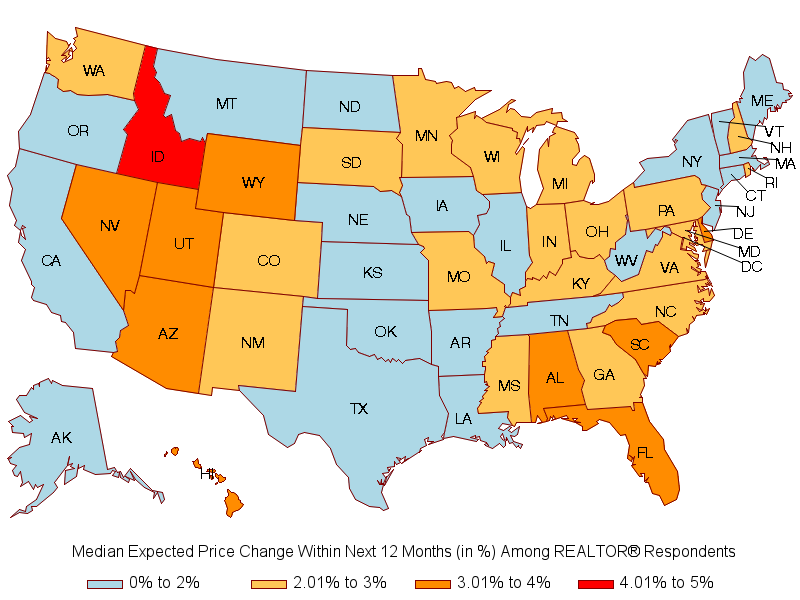In a monthly survey of REALTORS®, respondents are asked “In the neighborhood(s) or area(s) where you make the most sales, what are your expectations for residential property prices over the next year?”
Among approximately 3,000 REALTORS® who answered this question in the September 2018 REALTORS® Confidence Index Survey, the median expected price change in the next 12 months nationally is about two percent, a slower price appreciation compared to the 4.0 percent average during the January through May 2018 surveys (2.1 percent in August 2018 and 2.7 percent in September 2017).
The chart below shows the median expected price change across the U.S. states based on the responses of REALTORS® in the July, August, and September 2018 surveys.[1] Idaho is expected to have the strongest price growth at four to five percent. Home prices are expected to appreciate by a modest two to three percent in states such as Washington, Colorado, New Mexico, Ohio, Pennsylvania, Virginia, North Carolina, and Georgia. In 21 states that includes California, Oregon, Texas, New York, Massachusetts, Connecticut, and New Jersey, REALTORS® expect flat to two percent price growth over the next 12 months.

Based on Realtor.com median listing home price data, prices are still appreciating strongly in metro areas that are geographically near markets that have had strong price growth. Around Seattle-Tacoma-Bellevue (13.4%), the median listing prices rose year-over-year at double-digit pace in Centralia, WA (18.8%), Yakima, WA (15.4%), Olympia-Tumwater (16.4%), Aberdeen, WA (14.8%). Prices are also appreciating at double-digit rates in Boise City, ID (20.2%) and in Las Vegas-Henderson-Paradise, NV (17.8%) and adjacent Lake Havasu City-Kingman, AZ (15.6%). The median list price also rose at double -digit rates in Northeast region metro areas such as New York-Newark-Jersey City, NY-NJ-PA (10.9%) and Hudson, NY (15.9%).
The median listing home prices on Realtor.com were still up modestly on a year-over-year basis as of September 2018 in San Jose-Sunnyvale-Sta. Clara, CA (4.5%) and San Francisco-Oakland-Hayward (3.6%), but prices have been on a downtrend since May 2018. In San Jose-Sunnyvale-Sta. Clara, CA, the median list price has fallen from $1.28 million in May 2018 to $1.14 million in September 2018. In San Francisco-Oakland-Hayward, CA, the median list price has climbed down from $997,050 in May 2018 to $899,050 in September 2018.
The median home list price on Realtor.com were down year-over-year basis in metro areas such as Denver-Aurora-Lakewood, CO (-9.5%), Colorado Springs, CO (-3.4%), Austin-Round-Rock, TX (-3.4%); and Dallas-Fort Worth-Arlington, TX (-0.7%).
Home prices rose at a subdued pace in Northeast metros such as Boston, MA (3.7%), Bridgeport-Stamford-Norwalk, CT (0.9%), Hartford-East Hartford-West Harford, CT (1.2%), New Haven-Milford, CT (1.9%). However, there are pockets of strong growth such as Worcester, MA (8.7%).
Use the data visualization tool to explore how median listing prices are trending across metro areas:
[1] In generating the indices, NAR uses data for the last three surveys to have close to 30 observations. Small states such as AK, ND, SD, MT, VT, WY, WV, DE, and D.C., may have fewer than 30 observations.








